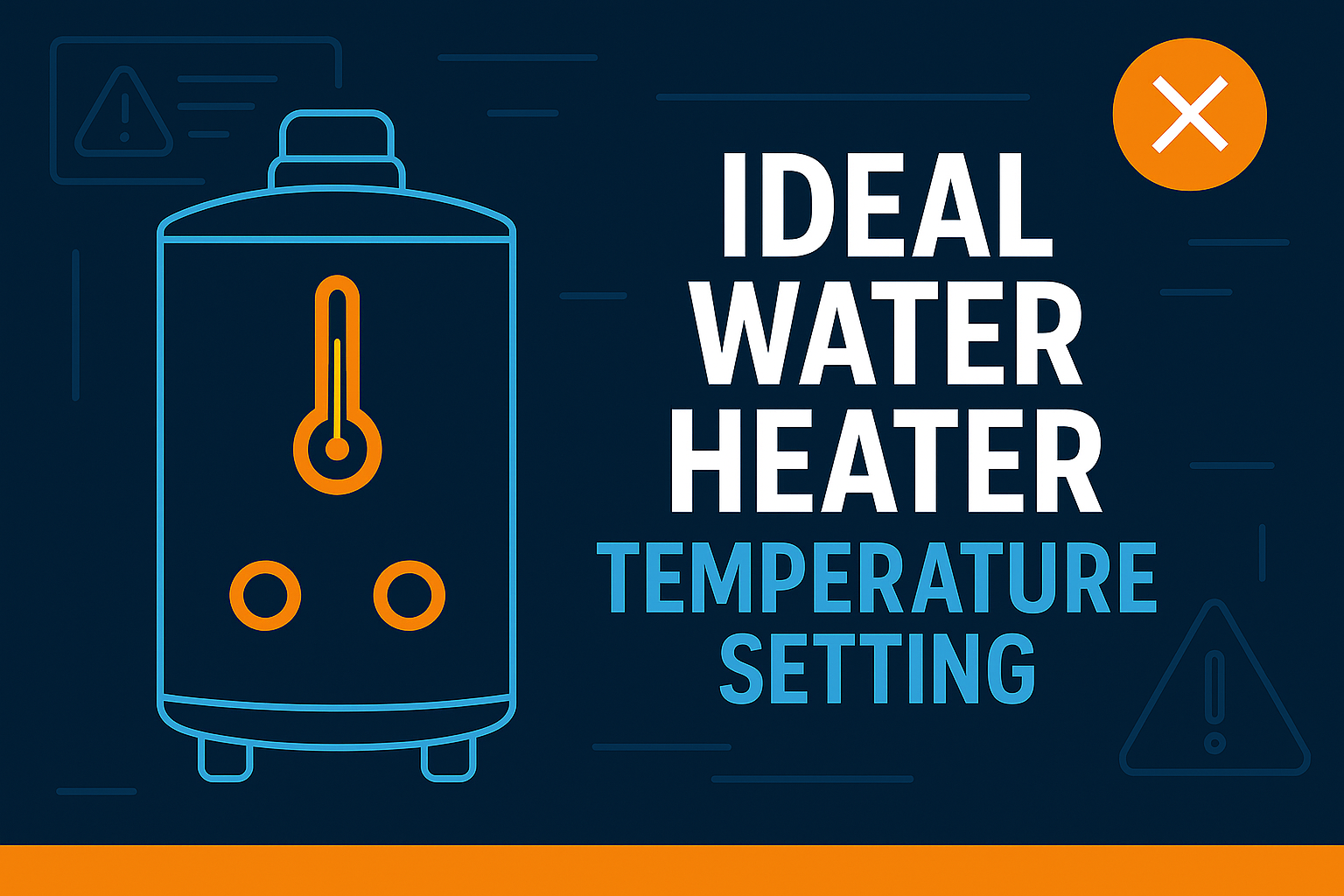Picture this: after a long, hard day or during the frosty depths of winter, there’s something truly indulgent about stepping into a hot, soothing shower at ideal water heater temperature setting. That cascade of warm water washing away the stress and chill is pure bliss. This is why a water heater system is a must-have for your home that guarantees your day-to-day comfort and well-being.
However, as winter approaches, you might have noticed your utility bills inching upwards. The cozy warmth of your shower doesn’t come without a cost. But don’t fret – that’s why we’re here. In this article, we’re going to uncover the secret to the perfect water heater temperature setting, one that strikes a harmonious balance between your comfort and your savings. Let’s dive in!
Why Does Hot Water Tank Temperature Matter?
You might be thinking, “Why bother with water heater temperature?” Well, it matters for a few key reasons. First and foremost, it’s about saving money. But there’s more to it than that. The right boiled water temperature ensures safety for all family members and helps maintain comfortable conditions for daily activities like bathing, dishwashing, and laundry.
The temperature setting directly affects how much energy your water heater consumes. The higher the temperature, the more energy it needs to maintain that level. By setting the right temperature, you can effectively lower your energy consumption and, consequently, reduce your monthly energy bills.
But money isn’t the only concern. Scalding accidents can be dangerous, especially if you have kids or seniors at home. Finding the right water heater temperature can prevent painful burns. Moreover, setting it correctly can help combat the growth of Legionella bacteria that thrive in water temperatures between 77°F and 108°F and can cause Legionnaires’ disease.
So, What Is the Ideal Water Heater Temperature Setting?
When it comes to water heater tank settings, the ideal boiled water temperature is a balance that brings together comfort, safety, and savings. In general, this balance is best struck when your water heater is set to about 120°F (49°C). This temperature is hot enough to meet your daily needs, including a relaxing shower or a steaming hot cup of tea, while also being energy-efficient and safe.
Now, let’s talk about the real deal – savings. In Canada, where winters can be harsh and energy bills tend to rise with the falling temperatures, setting your water heater to the recommended 120°F (49°C) can lead to significant savings. On average, this temperature setting can cut your water heating costs by 6-10%. For example, if you’re spending about $600 a year on hot water, this means you could save around $36 to $60 annually.
But what if your circumstances are unique? What if your family size, lifestyle, or the climate in your region make the “ideal” temperature setting not-so-ideal for you? Here are a few important considerations to fine-tune your water heater temperature:
- Household Size: Larger households with more people using hot water might find that a setting slightly higher than 120°F is more practical. Smaller households may comfortably stick to 120°F.
- Usage Patterns: If you run multiple appliances simultaneously, such as the dishwasher, washing machine, and shower, a slightly higher setting may prevent the water from turning cold mid-use.
- Climate: In regions with frigid winters, you might need hotter water to compensate for colder incoming water. However, avoid overheating, which can waste energy and cause safety risks.
- Anti-Scald Devices: If your plumbing has anti-scald devices, you can safely set the water heater at a slightly higher temperature.
Here is a simple guide to help you choose the best hot water tank temperature for your home:
| Temperature | Approximate Savings | Suitable For | Considerations |
|---|---|---|---|
| 100°F (38°C) | 10-15% | Homes with high scald risk (children, seniors) | Safer but may need booster for dishwashing |
| 120°F (49°C) | 6-10% | Most Canadian households | Balanced comfort, safety, and savings |
| 140°F (60°C) | 2-4% | Extremely cold climates, large families | Higher temps compensate for cold incoming water |
| 160°F (71°C) | 1-2% | Industrial or limited use | High scald risk, energy waste |
| 180°F (82°C) | Minimal | Disinfection purposes (non-residential) | Not recommended for homes due to scald risk |
While 120°F is a great starting point for most households, adjusting according to your personal needs ensures maximum comfort and efficiency.
If your water heater is not working properly or needs servicing, GM HEATING AND COOLING INC can help you troubleshoot and repair it promptly. Visit their website or contact their experts to ensure your system runs efficiently all year round.
Hot Water Tank Temperature Setting: Safety Precautions
Setting the right water heater temperature isn’t just about comfort and savings—it’s also about safety.
Scalding Prevention
Water hotter than 120°F can cause painful burns in seconds. This is particularly dangerous for children, the elderly, and people with sensitive skin. Setting your water heater to 120°F reduces this risk. For vulnerable individuals, lowering the temperature to around 100°F with the use of anti-scald devices can provide extra safety.
Anti-Scald Devices
These devices mix cold water with hot water to maintain safe temperatures at taps and showers. Installing anti-scald valves is an effective safety measure, especially in homes with children or elderly residents.
Legionella Prevention
Legionella bacteria can grow in water heaters set between 77°F and 108°F. To prevent this, keep the water heater temperature above 120°F. However, to balance safety, avoid setting it excessively high. If you’re concerned about Legionella but want to maintain energy savings, professional water treatment or filtration options can help.
Regular Maintenance
Regularly inspect your water heater for leaks, corrosion, and proper functioning of the temperature and pressure relief valve. GM HEATING AND COOLING INC offers expert maintenance services that ensure your water heater operates safely and efficiently.
Balancing Comfort and Budget Savings
Finding the ideal water heater temperature is also about balancing your comfort with cost savings. Here are a few tips to maximize both:
- Improve Insulation: Insulate your water heater tank and hot water pipes to reduce heat loss. This keeps water warmer for longer and cuts energy use.
- Use Energy-Efficient Appliances: Low-flow faucets, efficient dishwashers, and washing machines reduce hot water demand and lower energy bills.
- Adopt Water-Saving Habits: Shorter showers, fixing leaks promptly, and turning off taps when not in use conserve water and energy.
- Seasonal Adjustments: Adjust your water heater temperature slightly during summer and winter to match your hot water needs.
GM HEATING AND COOLING INC can provide energy audits and recommend products to improve your home’s water heating efficiency, helping you save more every month.
Conclusion
We hope this guide helped you find a delicate balance between comfort and savings. While 120°F (49°C) often emerges as the ideal water heater temperature setting, the overall approach matters most. Consider insulation, energy-saving appliances, water-wise habits, and seasonal adjustments. Combining these strategies will let you enjoy cozy hot showers while reducing your utility bills and your environmental impact.
If you need professional advice or assistance selecting and setting the ideal water heater temperature tailored to your home and lifestyle, don’t hesitate to contact GM HEATING AND COOLING INC. Their expert team is ready to help you optimize your water heating system for maximum safety, comfort, and savings.


